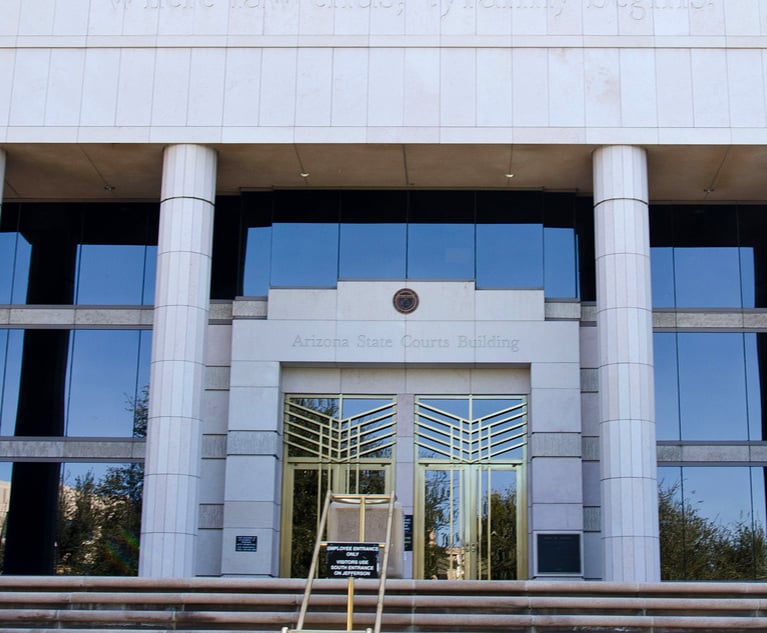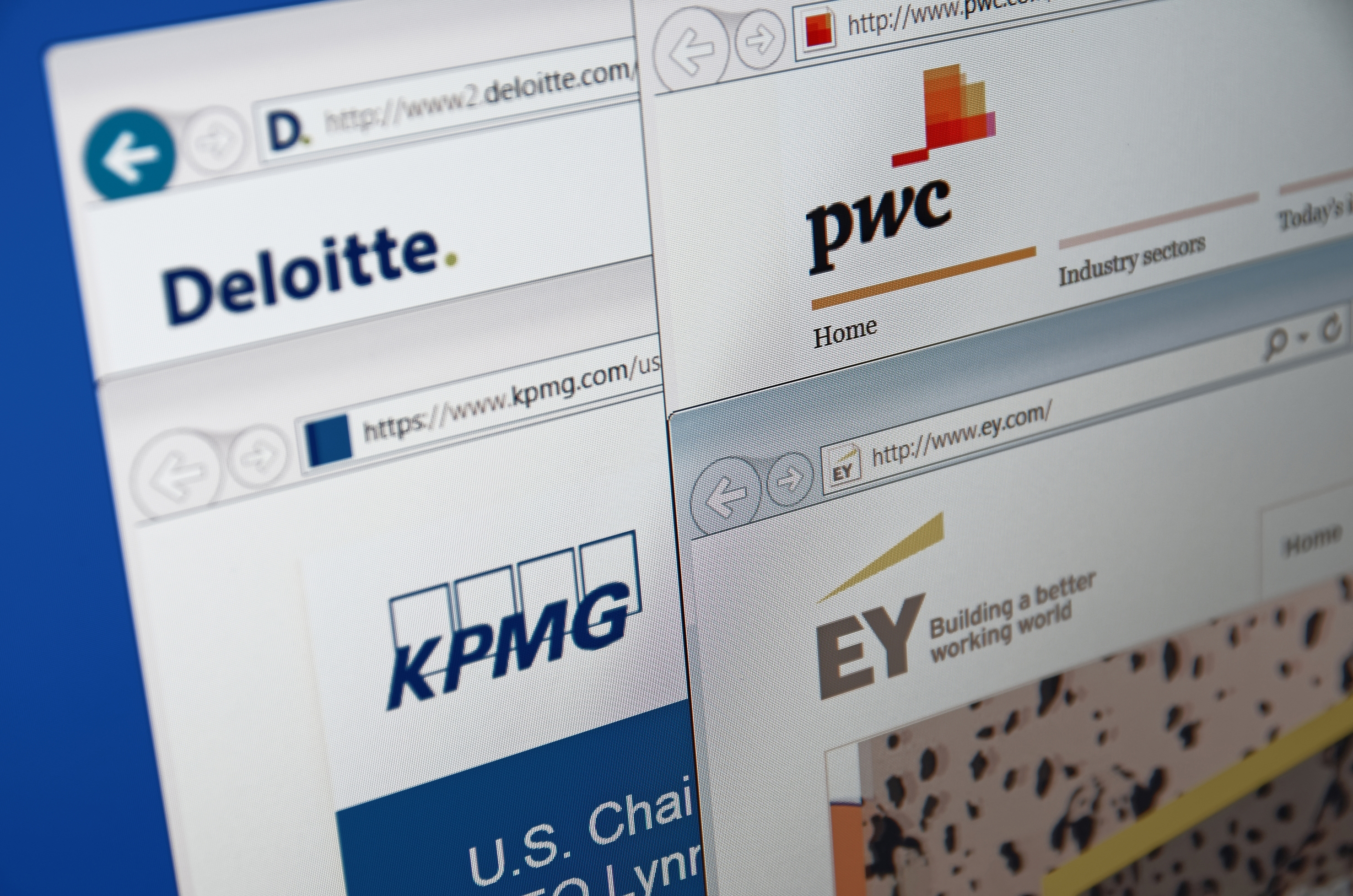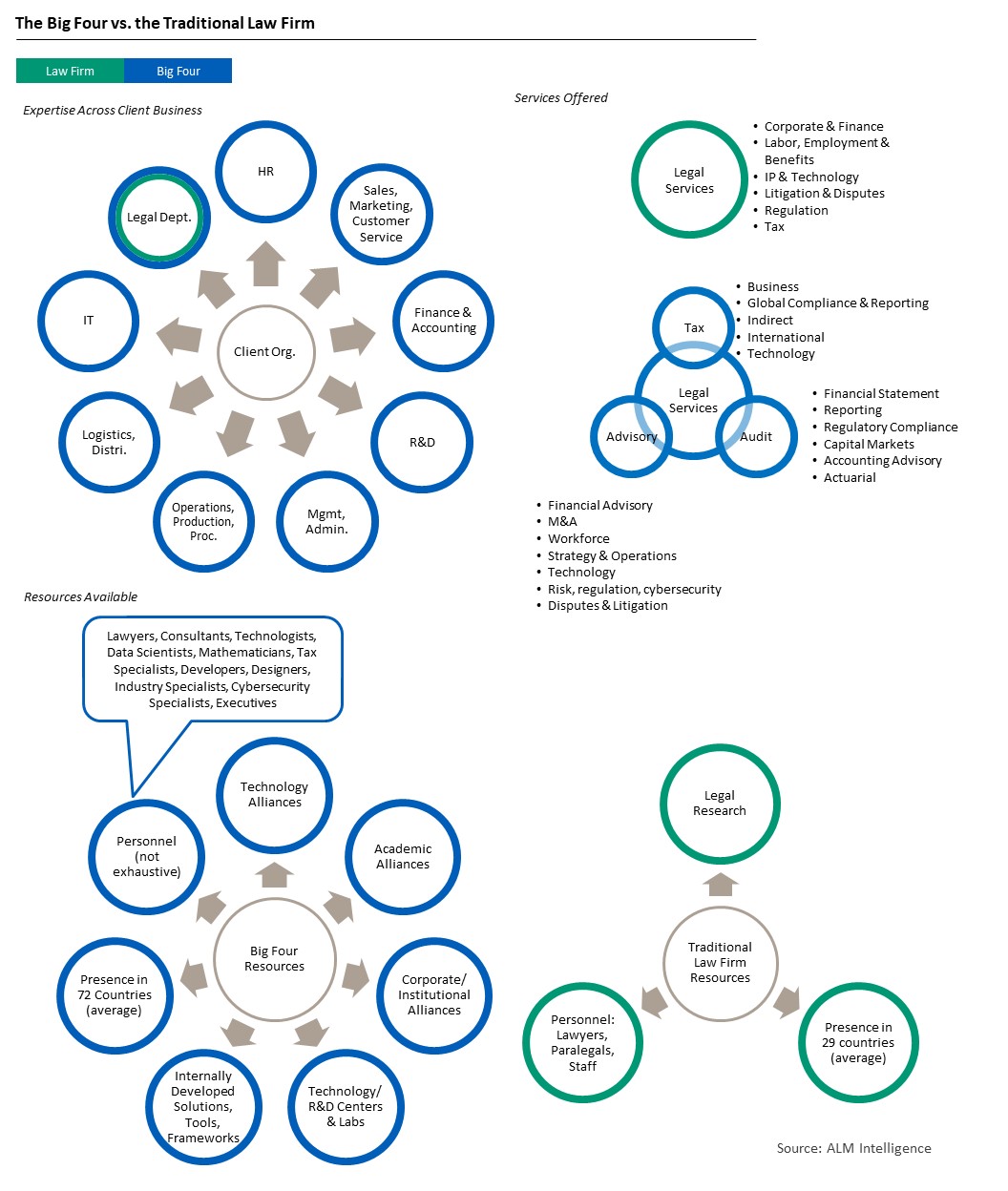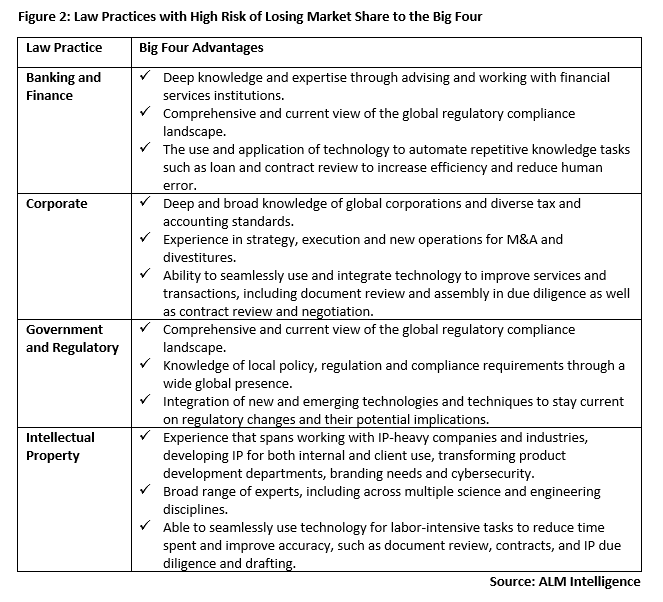The Big Four's push into the legal industry has gone from stealth mode to out-in-the-open-with-nothing-to-hide-mode. It's become clear these four firms have plans for the legal industry that they are now executing against. The question is – what are their plans?
What the Big Four have that law firms don't
Before we look to where the Big Four are likely headed in the legal industry, let's take stock of what they have that the traditional law firm does not. The Big Four (see Figure 1) have a broader reach and expertise across the client organisation, have a more diverse portfolio of services and have a deeper pool of resources.
Figure 1: The Big Four vs. the traditional law firm
The Big Four are also very efficient and process-driven. This is a huge differentiator for the Big Four. Their focus on efficiency – and even incentivising it – is a stark contrast to law firms, which still heavily rely on the billable hour, which rewards inefficiency.
And, the Big Four have technology. A lot of technology. There are three primary ways these four firms bring technology to their clients, including to the legal department:
No.1: Leverage existing technology from the organisation: The Big Four have an abundance of operational and client-proven tools and technology that they are continuously improving. As members of these organisations, much of what has been used in a different part of the organisation can be brought in and tailored, as needed, for the corporate legal department. For example, the legal services arms of the Big Four access and use cloud-based collaboration platforms that allow for seamless teamwork across the client, as well as with the legal, advisory and tax groups of the Big Four.
No. 2: Use internal labs, centres and R&D: The Big Four have an arsenal of labs, centres and research groups at their disposal, ranging from centres of excellence to collaborative development centres to funding for strategic initiatives. The most recent significant investments these firms have made are in collaborative, interactive labs: Deloitte has Greenhouses and Studios, EY has wavespaces, KPMG has Ignition Centres and Innovation Centres, and PwC has Experience Centres. These centres are dedicated locations where both the firm and the client can work together in an interactive environment and where the firm researches and develops new tools, methods and technologies for both current clients and for help in addressing future needs. Each of the Big Four has multiple locations worldwide and from these centres, they can offer design capabilities, demonstration capabilities, workshop capabilities, research and pilot capabilities, and in some cases, client delivery.
➤➤ Effective legal collaboration strategies and innovative partnerships will be explored on day one of LegalWeek CONNECT, taking place on 28-29 November at County Hall, London SE1. Click here for more information
These firms also have cybersecurity centres around the globe that, depending on the firm, offer a variety of services, including managed services, threat intelligence, and research combined with solution development and implementation. Deloitte's Cyber Intelligence Centres provide clients with a 24/7 cybersecurity solution that spans consulting, implementation and managed services across threat intelligence and incident response. Another example is EY's cybersecurity centre in Dallas that offers 24/7 cyber-managed services, cyber innovation (technologies, methodologies and strategies), Cyber Academy (training and certification to EY and clients), executive briefings and Cyber Range (solution trials, scenarios). The Big Four's more traditional centres of excellence and R&D efforts also cover specific topics such as cognitive analytics and blockchain, which have both started to impact the legal industry. From these efforts, the Big Four have developed significant resources surrounding leadership, research, support and best practices for each topic.
These research, collaboration and development capabilities allow the Big Four to develop internal tools and technology that draw on organisational-wide knowledge. Deloitte, for example, stays on top of the legal AI market through testing all new products to the market in a lab setting, while EY Legal Services works alongside EY's advisory services to hold GDPR workshops for clients in their wavespace facilities.
No. 3: Collaborate with alliance partners: The Big Four have a wide-reaching partner and alliance ecosystem. Not only do they have close relationships with the major technology companies (e.g. Apple, AWS, IBM, Oracle, Salesforce), but they also collaborate with lesser-known and niche companies (e.g. blueprism, Securonix). The Big Four's ecosystem also extends beyond technology partners into non-technology companies, academia and other organisations, such as Los Alamos National Laboratory (with EY) and Singularity University (with Deloitte). Knowledge, along with tools and technologies from these alliances and others, extend across the Big Four organisations and include solutions to challenges within the legal industry. With their multidisciplinary capabilities, the Big Four are able to work with legal technology partners to improve existing technology and deliver new solutions for use in their own service delivery and to assist clients in the adoption, execution and maintenance of their legal technology solutions.
Immigration law – a good place to start
Given the Big Four's capabilities, immigration law is a good match. This document- and process-heavy sector is ripe for process-improvement measures, with technology leading the helm. KPMG, for example, has a web-based system for immigration management that manages and optimises the immigration process, acting as a single point of access for both legal leadership and KPMG immigration specialists. The system is used to initialise, authorise and manage cases.
The broader labour and employment practice area is also logical. The Big Four have broad experience with the human resources function, which includes strategy, HR transformation and development of policies and procedures. They also have a wide global presence providing insight into local, regional and national government-level labour, employment and immigration laws. More importantly, the Big Four are able to seamlessly use and integrate technology to enable collaboration, improve communication and reporting, and create and implement best practices.
There are several other practice areas we should expect to see the Big Four pop-up in:
Start low, aim high
As we're seeing, the Big Four are capturing parts of the legal market that align and extend their existing services. These firms are also best positioned to target and capture the lower-priced or more 'commoditised' legal work that is usually characterised by high volume and low value (both economically and strategically) because of their dominant technology and process optimisation expertise. However, as the needs of the corporate legal department evolve into integrating more with business processes and strategy, the Big Four will be viewed more favorably for mid- and higher-value legal work, because these organisations can provide sophisticated and completely integrated areas of expertise that go beyond a purely traditional legal perspective.
If you're a law firm, stay tuned.
This content has been archived. It is available through our partners, LexisNexis® and Bloomberg Law.
To view this content, please continue to their sites.
Not a Lexis Subscriber?
Subscribe Now
Not a Bloomberg Law Subscriber?
Subscribe Now
NOT FOR REPRINT
© 2025 ALM Global, LLC, All Rights Reserved. Request academic re-use from www.copyright.com. All other uses, submit a request to [email protected]. For more information visit Asset & Logo Licensing.
You Might Like
View All

Some Elite Law Firms Are Growing Equity Partner Ranks Faster Than Others
4 minute read
KPMG's Bid To Practice Law in US On Hold As Arizona Court Exercises Caution
Trending Stories
Who Got The Work
J. Brugh Lower of Gibbons has entered an appearance for industrial equipment supplier Devco Corporation in a pending trademark infringement lawsuit. The suit, accusing the defendant of selling knock-off Graco products, was filed Dec. 18 in New Jersey District Court by Rivkin Radler on behalf of Graco Inc. and Graco Minnesota. The case, assigned to U.S. District Judge Zahid N. Quraishi, is 3:24-cv-11294, Graco Inc. et al v. Devco Corporation.
Who Got The Work
Rebecca Maller-Stein and Kent A. Yalowitz of Arnold & Porter Kaye Scholer have entered their appearances for Hanaco Venture Capital and its executives, Lior Prosor and David Frankel, in a pending securities lawsuit. The action, filed on Dec. 24 in New York Southern District Court by Zell, Aron & Co. on behalf of Goldeneye Advisors, accuses the defendants of negligently and fraudulently managing the plaintiff's $1 million investment. The case, assigned to U.S. District Judge Vernon S. Broderick, is 1:24-cv-09918, Goldeneye Advisors, LLC v. Hanaco Venture Capital, Ltd. et al.
Who Got The Work
Attorneys from A&O Shearman has stepped in as defense counsel for Toronto-Dominion Bank and other defendants in a pending securities class action. The suit, filed Dec. 11 in New York Southern District Court by Bleichmar Fonti & Auld, accuses the defendants of concealing the bank's 'pervasive' deficiencies in regards to its compliance with the Bank Secrecy Act and the quality of its anti-money laundering controls. The case, assigned to U.S. District Judge Arun Subramanian, is 1:24-cv-09445, Gonzalez v. The Toronto-Dominion Bank et al.
Who Got The Work
Crown Castle International, a Pennsylvania company providing shared communications infrastructure, has turned to Luke D. Wolf of Gordon Rees Scully Mansukhani to fend off a pending breach-of-contract lawsuit. The court action, filed Nov. 25 in Michigan Eastern District Court by Hooper Hathaway PC on behalf of The Town Residences LLC, accuses Crown Castle of failing to transfer approximately $30,000 in utility payments from T-Mobile in breach of a roof-top lease and assignment agreement. The case, assigned to U.S. District Judge Susan K. Declercq, is 2:24-cv-13131, The Town Residences LLC v. T-Mobile US, Inc. et al.
Who Got The Work
Wilfred P. Coronato and Daniel M. Schwartz of McCarter & English have stepped in as defense counsel to Electrolux Home Products Inc. in a pending product liability lawsuit. The court action, filed Nov. 26 in New York Eastern District Court by Poulos Lopiccolo PC and Nagel Rice LLP on behalf of David Stern, alleges that the defendant's refrigerators’ drawers and shelving repeatedly break and fall apart within months after purchase. The case, assigned to U.S. District Judge Joan M. Azrack, is 2:24-cv-08204, Stern v. Electrolux Home Products, Inc.
Featured Firms
Law Offices of Gary Martin Hays & Associates, P.C.
(470) 294-1674
Law Offices of Mark E. Salomone
(857) 444-6468
Smith & Hassler
(713) 739-1250












